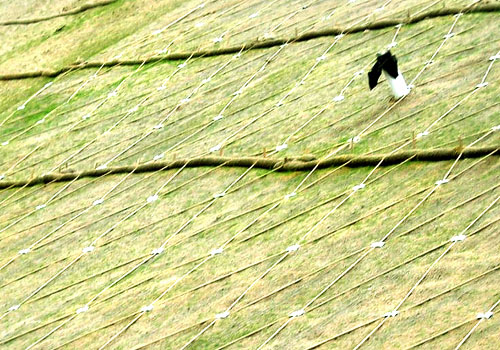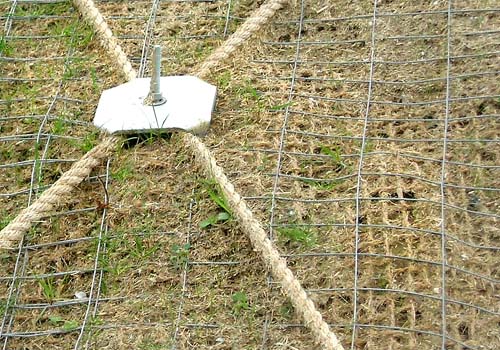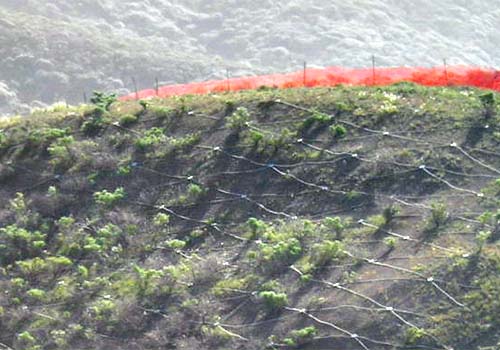Erosion Control Toolbox: Wire Blanket
Introduction


Wire blanket is composed of biodegradable coir netting sandwiched between welded wire mesh, and held in place with slope anchors. Vegetative cover is provided by a hydroseeded application of fiber, seed, and fertilizer.
When to Use This Treatment
- Use for cut slopes between 2:1 and 1.5:1 (H:V)
- Use of this product should be coordinated with the Division of Engineering Services (DES) Office of Geotechnical Services
This treatment includes the following products:
Netting
Netting consists of a braided coir strand weave with 3/4 inch openings that yield a 63-70% open area, which is sufficient to germinate hydroseed. The netting has an estimated life span of 4-6 years.
Using Rolled Erosion Control Product (Netting) instead of Rolled Erosion Control Product (Blanket) allows erosion control materials to be applied as the last treatment. When using blankets, hydroseed must be applied prior to the placement of the blanket. On steep slopes erosion control material may be displaced, migrate and be covered during placement and anchoring of the blanket. This results in spotty vegetative growth. Use of coir netting is advantageous when stabilizing disturbed slopes at the earliest opportunity because a general contractor can install the mechanical erosion control materials and then call in a hydroseed contractor at a later date.
Wire Mesh
Welded wire mesh with nominal openings of 2" x 4" is placed atop the coir netting to help prevent slope slumping. The wire mesh provides mechanical support while the coir netting controls surface erosion. Adjoining sections of wire mesh are fastened together with 10-gage wire.
Slope Anchor
Wire mesh and coir netting are fastened in place with slope anchors. Composed of either ductile iron or aluminum, the slope anchor is designed to provide holding capacity and pull out resistance. A 1/2 inch diameter threaded anchor rod, 30 inches in length, secures the anchor to a surface mounted plate. Anchor plates, as seen in the photo above, are composed of corrosion-resistant metal or hardened polyethylene.
Hydroseed
The final element is an application of Erosion Control (Hydroseed) over the netting face. The hydroseed materials are applied at close range so that materials are well integrated into the netting face and in contact with the soil surface below.
A typical hydroseed seed mix consists of native grass species with a sterile cereal grain such as Briggs barley, Re-green (triticum) or California red oats. Cereal grains provide quick vegetative cover and grow in shallow soils with low nutrient value. Sterile cereal grains are not invasive or persistent. This is desirable in native plant communities where revegetation will occur naturally and introducing non-native plant material is of concern.


Benefits
- Provides immediate slope reinforcement
- Increases infiltration rates on dry sites
- Provides for vegetation establishment, cover, and natural recruitment
Limitations
- Unsuitable for rocky slopes as it is difficult for slope anchors to fasten the materials in place
Consider Using With
To effectively treat sites with compacted, sterile or poorly draining soils, consider combining this treatment with:
Updated: February 12, 2019

